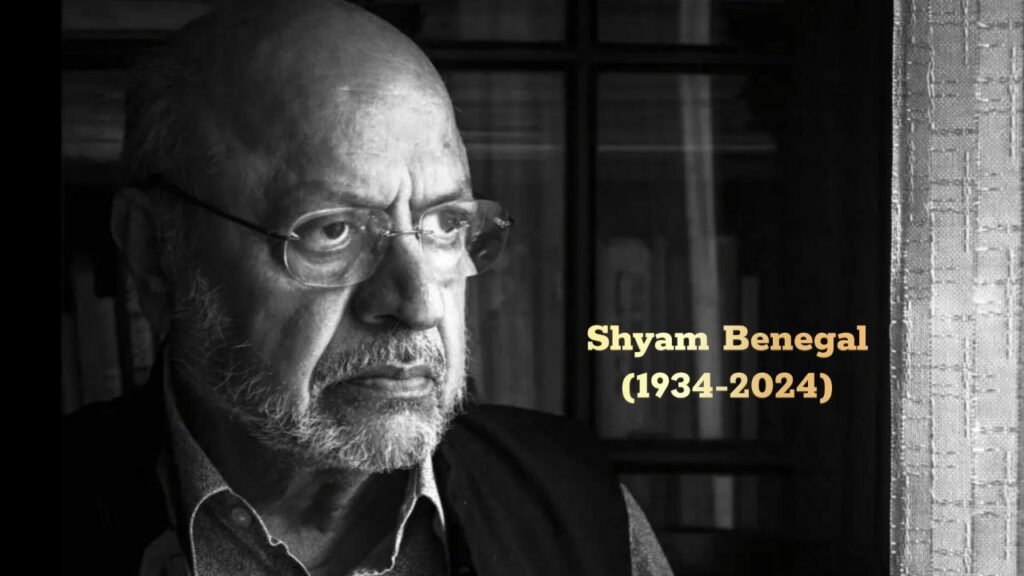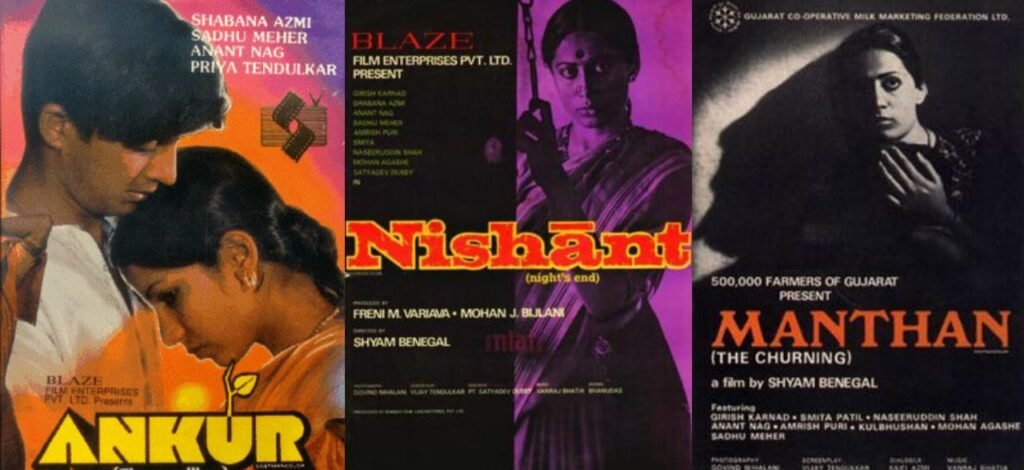A Tribute to an Icon of Indian Cinema
Shyam Benegal, one of the most influential filmmakers in the history of Indian cinema, died on 23 December 2024 at the age of 90, leaving behind a monumental legacy that has shaped the trajectory of Indian filmmaking. A pioneer of the parallel cinema movement, Benegal’s work stood as a powerful antidote to the commercial mainstream cinema of his time. His films, often rich in social commentary, realistic portrayal of human emotions, and unflinching critique of society, earned him both national and international acclaim. His death marks the end of an era, but his contributions will forever remain embedded in the fabric of Indian cinema.

Early Life and Beginnings in Cinema
Born on December 14, 1934, in Hyderabad, Shyam Benegal’s journey into the world of cinema was deeply rooted in his early exposure to the arts. His initial interest in film came from his background in literature and theatre, where he was exposed to the world of storytelling through different mediums. Benegal initially studied at Osmania University in Hyderabad, where he began to develop an interest in filmmaking and drama. His early work was shaped by the cultural landscape of India in the 1950s and 1960s, a time when the country was undergoing significant social and political transformation.
Benegal’s professional journey in filmmaking began after he moved to Mumbai in the late 1950s. He started his career as a documentary filmmaker, honing his skills in storytelling and cinematography. His work in documentaries helped him develop a keen eye for detail and an understanding of human life and society, which would later become the hallmark of his feature films.
A New Voice in Indian Cinema: Parallel Cinema Movement
By the 1970s, Benegal became one of the leading figures in the rise of parallel cinema, a movement in Indian filmmaking that sought to challenge the conventions of commercial Bollywood cinema. Unlike the song-and-dance-filled narratives of mainstream films, parallel cinema aimed to present realistic, socially relevant stories, often exploring the lives of ordinary people and delving into themes of class, gender, and politics. This was a stark contrast to the escapist fantasy that dominated the film industry at the time.
Benegal’s first feature film, Ankur (1974), marked the beginning of a new era in Indian cinema. The film, which explored the lives of a rural couple caught in the complexities of class and power dynamics, immediately established Benegal’s ability to craft sensitive, thought-provoking narratives. The film’s raw, unflinching portrayal of social issues such as feudalism and the abuse of power resonated deeply with audiences, and it won the Filmfare Award for Best Film.
This film set the tone for much of Benegal’s career. His films did not shy away from uncomfortable truths and often painted a stark picture of Indian society. His characters were complex, real, and flawed, never reduced to mere stereotypes. Through films like Nishant (1975), which tackled issues of injustice, and Manthan (1976), a film about the cooperative dairy movement, Benegal showcased his signature style of blending social commentary with compelling storytelling.

Pioneering Social Realism: Benegal’s Signature Style
What set Shyam Benegal apart from other filmmakers of his time was his commitment to social realism. While many filmmakers were still rooted in melodrama and fantasy, Benegal’s films were firmly grounded in reality. His work often featured ordinary people grappling with the complexities of Indian society, and his characters were rarely black-and-white; instead, they were multi-dimensional, reflecting the nuances of real life.
For example, in Bhumika (1977), Benegal explored the life of a Marathi stage actress, played by Smita Patil, who struggles to reconcile her personal desires with the demands of her career and the patriarchal world around her. The film was a bold exploration of female agency, and Patil’s portrayal of the central character earned her widespread acclaim. Bhumika is often hailed as one of Benegal’s finest works, not only for its portrayal of a woman’s inner conflict but also for its critique of the film industry itself, which often objectified women for the sake of commercial success.
Similarly, Kalyug (1981), a modern retelling of the Mahabharata, explored the moral dilemmas of a contemporary family caught in a web of corruption and power struggles. Benegal’s choice of adapting such an ancient text to reflect modern-day issues was a testament to his ability to bring classical ideas into a modern context, making them relevant to contemporary audiences.
Throughout his career, Benegal was able to bring a unique blend of intellectual depth and emotional resonance to his films. He had a rare ability to make complex social issues accessible, using the medium of cinema to make a profound statement about Indian society. His films never shied away from difficult topics, whether it was the rural-urban divide, caste discrimination, or political corruption. His work was often a mirror to the socio-political landscape of India, and in this sense, Benegal was not just a filmmaker but a chronicler of his time.
The Art of Direction and Performance
One of the defining features of Benegal’s films was his impeccable direction, which often brought out nuanced performances from his actors. He was known for creating a collaborative environment on set, allowing actors to experiment with their roles while maintaining a strong narrative vision. This approach resulted in some of the most memorable performances in Indian cinema, particularly from actors like Shabana Azmi, Smita Patil, Naseeruddin Shah, and Amrish Puri.
In Nishant (1975), a powerful drama about the exploitation of women and the oppression of peasants, Benegal worked with a talented ensemble cast, including Naseeruddin Shah and Shabana Azmi, to deliver a compelling narrative of resistance. The film was notable for its strong performances, which Benegal was able to coax out of his actors through his meticulous direction.
Smita Patil, who became one of the most iconic actresses in Indian cinema, was another of Benegal’s key collaborators. Their partnership produced some of the most memorable performances in Indian cinema, with Patil giving outstanding performances in Bhumika (1977), Manthan (1976), and Chidambaram (1985), a film that focused on the traditional Indian dance form of Bharatanatyam.
Benegal’s actors were not just performers; they were integral to his storytelling. His films required actors to be deeply engaged with the material, and he pushed them to deliver performances that were both authentic and emotionally resonant. The result was a body of work in which the characters seemed to leap off the screen, their struggles and triumphs deeply felt by the audience.
Legacy and Influence on Indian Cinema
Shyam Benegal’s contribution to Indian cinema extends beyond his individual films. He was also a mentor to many young filmmakers and an advocate for the growth and development of Indian cinema. In the 1990s, Benegal was appointed as the chairman of the National Film Development Corporation of India (NFDC), where he worked to support and nurture independent filmmaking in India. His role in the NFDC helped provide a platform for many emerging filmmakers who would go on to shape the future of Indian cinema.
Benegal was also involved in the creation of film festivals and initiatives that aimed to showcase Indian films on the international stage. His efforts contributed to bringing Indian cinema to a global audience, with his own films being featured at prestigious international film festivals such as Cannes and Berlin.
In recognition of his outstanding contributions to cinema, Shyam Benegal received numerous awards, including the Padma Bhushan, one of India’s highest civilian honors, in 2005. His films earned critical acclaim not just in India but across the world, and they continue to be studied by film students and cinephiles alike.
Benegal’s influence can also be seen in the work of contemporary filmmakers who have drawn inspiration from his bold storytelling style, commitment to social realism, and willingness to explore complex, often controversial themes. Filmmakers like Anurag Kashyap, Rima Das, and Zoya Akhtar have cited Benegal as a major influence on their own careers, and his films remain a benchmark for those working in the field of independent cinema.
The End of an Era
The passing of Shyam Benegal marks the end of an era in Indian cinema. His films were not just entertainment; they were a reflection of society’s struggles, triumphs, and contradictions. Benegal was a master at capturing the nuances of life, and his films will continue to resonate with audiences for generations to come. As the world of cinema moves forward, it is hard to imagine Indian cinema without the indelible mark left by Shyam Benegal.
His death is a significant loss, but it also serves as a reminder of the enduring power of cinema to shape our understanding of the world. Benegal’s legacy is not just in the films he made, but in the path he paved for future filmmakers—one that continues to inspire those who believe in the transformative power of cinema.
In conclusion, Shyam Benegal’s contribution to Indian cinema cannot be overstated. His films captured the essence of Indian society and brought to the forefront voices and stories that had long been silenced. As we remember the life and work of this great filmmaker, we celebrate the rich legacy he leaves behind—a legacy that will continue to inspire, challenge, and captivate audiences for years to come.
